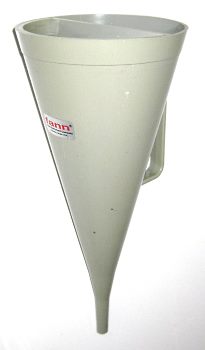property>kinematic viscosity
What is Kinematic Viscosity?

The resistance of a fluid that is being deformed from shear stress or extensional stress is called viscosity. In general it is the "thickness" of a fluid. It can be thought of as fluid friction or internal resistance of a fluid to flow, and specifically the kinematic viscosity measures the resistance to flow of a fluid under the influence of gravity (or some other body force acting on the mass of the fluid). Usually a thin liquid like water has less viscosity as compared to a thick fluid like honey having high viscosity. The kinematic viscosity is highly dependent on temperature. The kinematic viscosity of a liquid usually decreases with increase in temperature whereas the kinematic viscosity of a gas increases.
Types Of Fluid
Newtonian Fluids
Fluids in which shearing stress is linearly related to rate of shearing strain are called Newtonian fluids or true liquids, since agitation or pumping at constant temperature does not affect their viscosity or consistency. Most common liquids and gases are Newtonian fluids, such as water, oil and air.
Thixotropic Fluids
Those fluids which reduce their viscosity, when agitation or pressure is increased, keeping temperature constant, are known as Shear Thinning Fluids or Thixotropic Fluids. They appear to be thick or viscous but they can be pumped quite easily.
Dilatant Fluids
Those fluids that increase their viscosity with the increase in agitation or pressure under constant temperature are called Shear Thickening Fluids or Dilatant Fluids. Such fluids can become solid when flowing within a pipe. For example cream becomes butter if agitated.
Measuring Kinematic Viscosity
Kinematic viscosity can be measured using a device called a capillary viscometer which consists of a graduated canister with a narrow tube at the bottom. The liquid is placed in the container and allowed to flow by gravity. The higher the viscosity, the longer it takes to flow through the tube (i.e. a fluid with less viscosity will take less time to flow than a fluid with higher viscosity). Kinematic Viscosity is the ratio of absolute or dynamic viscosity to density - a quantity in which the force is external and independent of the mass of the fluid. Kinematic viscosity can be obtained by dividing the dynamic viscosity of a fluid by its density.
ν = μ / ρ
where ν = kinematic viscosity, μ = absolute or dynamic viscosity, ρ = density. In the SI-system the unit is m2/s
The Stokes(St) is the cgs physical unit for kinematic viscosity, named after George Gabriel Stokes, where 1 St = 10-4 m2/s. It is also expressed in terms of centistokes (cSt or ctsk). 1 stokes = 100 centistokes = 1 cm2•s-1 = 0.0001 m2•s-1. 1 centistokes = 1 mm2•s-1 = 10-6m2•s-1.
The kinematic viscosity can also be called diffusivity of momentum since it has the same dimensions as the diffusivity of heat and diffusivity of mass concentration. The transport of momentum is analogous to the transport of other properties of a fluid. This also means that it can be used in many dimensionless numbers to compare ratios of diffusivities, and hence the relative importance of different physical processes.